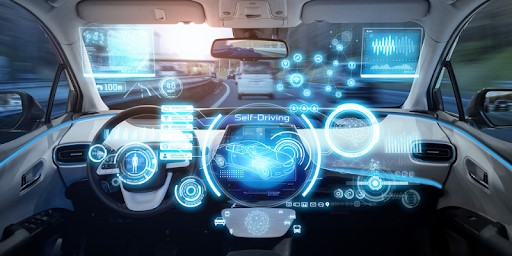The technology of self-driving cars is one of the recent advancements in the transport sector that has marked a shift in transport technology. These self-driving cars employ or incorporate modern technological advancement in their operations and navigate without a human driver. The essence of this innovation is Artificial Intelligence (AI) to enable the vehicle to comprehend the circumstances around them, determine some activities, and maybe even respond to incidences they encounter. This blog topic will cover what Artificial Intelligence plays in Self-Driving Cars and its role in safety, productivity, and user satisfaction. Enrolling in AI Courses in Chennai can provide valuable insights into the technological advancements behind AI in self-driving vehicles.
Autonomous Vehicles
Self-driving cars are equipped with technologies such as sensors, cameras, and artificial intelligence through which the car can interpret roads and navigate them without the help of a human. These vehicles can be operated at whatever tolerance one wants, starting with automatic flying mode to fully automated. It is possible to identify how AI technology must be applied to handle enormous amounts of data from sensors and make decisions in real-time.
Perception and Sensing
Perception is one of the most mainstream roles of AI to be implemented in self-driving cars. This includes Jeopardizing data from different sensors and coming up with an all-rounded or holistic view of the environment surrounding the vehicle. This information is then processed by AI algorithms to recognize objects like pedestrians, other cars, traffic signals, and signs.
To improve the perception of the vehicle, machine learning algorithms are integrated into it. When AI models are trained using large datasets, the system’s object detection and classification performance is enhanced even when the environmental conditions are poor or there is low lighting. This understanding helps in avoiding obstacles in our way apart from enabling us to make the right movements without encountering harm in the process.
Decision-Making and Control
One of the main issues affecting the creation of self-driving cars is safety. The use of AI makes it possible for the vehicle to respond to various dangers in a very brief period. The system can monitor the speed of the surrounding vehicles, distance to the obstacles, and traffic conditions thus making quick decisions to avoid any incidence that may harm passengers or other people on the road.
Reinforcement learning is one such technique employed in this context. The decision-making process evolves as the system collects experience from simulations and actual driving situations. This type of learning makes it easier for the vehicle to manage these issues and do so in the best ways possible.
Safety and Reliability
One of the main issues affecting the creation of self-driving cars is safety. It is safe to say that AI improves safety since the car can maneuver well in response to danger. The system can determine a set of parameters at once and make a decision within a second to avoid dangerous impacts on passengers and pedestrians near the vehicle.
In addition, AI can always be aware of the performance level of a vehicle as well as note anything that seems out of the ordinary. When the system detects a failure or a threat it can respond with appropriate measures like reducing the speed or stopping the car. Such reliability is very important if society is to embrace this autonomous technology.
Improving User Experience
While AI is the key element that enables improving safety and efficiency, its application in vehicles also improves user experience. Some of the additional characteristics include voice commands and user preferences, and that would make the ride more pleasant. For instance, the passengers can input their locations of interest in plain language and let the self-driving vehicle’s AI system help out with instruction.
Further, AI is capable of reading traffic patterns for route planning and presenting new directions if necessary due to traffic issues. This capability also adds up to time-saving aside from reducing fuel usage, thus making it a more environmentally friendly transport network. Taking an Artificial Intelligence Course in Bangalore can help you understand the underlying technology that enables such innovations in transportation.
AI is responsible for the change in autonomous vehicles in the areas of safety, efficacy, and user satisfaction. By benefitting from perception, decision, and learning capability, those vehicles can move and make the right decisions in complicated scenarios. By enhancing the rationality of the technological development of transport systems, AI will remain instrumental in the future transport systems of society. The path to true automated vehicles is not solely a technological process but it is an explorative one that will change the perceptions of mobility.
FAQ’S
Where lies autonomy in automotive vehicles?
AI enables self-driven cars to perceive the conditions around them, reason, and decide by evaluating inputs gathered through detection devices such as cameras, and other related hardware in real-time.
They were asking themselves how it may help to enhance the safety of self-driving vehicles.
AI is able to trace obstacles, foresee traffic situations, and respond to possible danger with much less time than any human driver, hence decreasing the possibility of any accident occurrence.
What specific AI technology can be utilized in the automobile industry, especially in self-driven cars?
AI and Machine learning, computer vision, and deep learning concepts help self-driving cars detect objects, understand traffic signals and signs, and improve with each ride.
Is it possible that AI can take control of all the conditions that can be encountered on the roads by self-driving cars?
Nevertheless, several cases need attention from human operators or can be improved further in terms of automation.
In self-driving cars, how does AI collect data?
AI captures signals from various types of sensors, including radar, lidar, and cameras to build a detailed real-time map of the vehicle environment for making driving decisions.
What’s more, in the cases of self-driving cars, how is the AI involved in the decision-making process of the vehicle?
The applications of AI algorithms involve processing data from sensors, evaluating the state of the roads, and choosing actions such as braking, accelerating, or steering to avoid endangerment.
In other words, how do autonomous vehicles depend on artificial intelligence to identify objects?
AI applies computer vision, along with a combination of sensors to detect objects like pedestrians, other cars, and traffic signs and act correspondingly.
What role does AI play in autonomous vehicles or is the use of AI solely to drive the vehicle?
No, AI is also used in vehicle-to-vehicle conversations, in handling maintenance requirements, and even as a customer preference adjustment for passengers within the car.
In developing self-driven automobiles, what trends is AI faced with?
Some of the issues include difficult driving situations, ethical dilemmas in making decisions during an emergency, and lastly assuring that AI offers optimum performance under all weather conditions.

